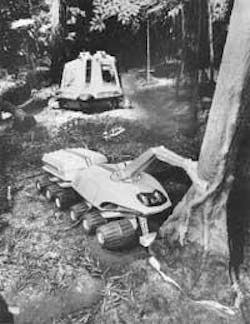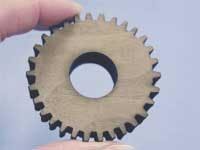Tree felling with lasers: a big idea in 1965
Reading through the first issues of Laser Focus magazine, it is amazing to see how many laser applications were being contemplated or even becoming commercially viable so soon after the development of the laser. Lasers for zapping tumors, communicating between Earth and space, for writing optical memory, and even for use as stimulators in ion propulsion were some very early ideas that are now commonplace or in advanced stages of development. But some ideas, such as tree felling with lasers, never materialized. Although scientists seemed to understand that tree felling was not a practical application for lasers, that didn’t stop the visionaries of the day from telling the world about the ominous potential for laser tree-cutting technology at the 1964/1965 World’s Fair.
Woodworking, not tree cutting
While it was first reported in the Feb. 15, 1965, issue of Laser Focus that felling trees with lasers was being researched by the University of Michigan and the U. S. Forest Products Laboratory in Madison, WI, a later story in the April 1 issue, “Woodworking—not tree felling—laser’s forte,” retracted the finding. The article noted that investigation into the report had, however, unearthed an interesting paper resulting from research done two years earlier by the same principals.1 Apparently, Norman C. Franz of the University of Michigan’s Department of Wood Science and Technology confirmed that tree felling was only an idea. “Equipment is not available at this time to even research such a project,” he said.
Instead, the research subjected wood samples with a range of densities to repeated laser pulses of less than 1-ms duration from a ruby laser with a maximum energy output of 3 J per pulse. Although depth of penetration was less than 1/16 in. per pulse for a 0.03-in.-diameter hole, it was concluded that the laser could be a practical wood-machining tool if a high-power, continuous-beam, more-economical laser system could be developed.
In the Oct. 1, 1965, issue of Laser Focus, William G. Prince, of the Laser Systems Center of Lear Siegler in Ann Arbor, MI, in “The Laser as an Industrial Tool,” mentions the potential use of lasers in tree cutting, but quickly moves on to describe lasers for welding applications and for drilling holes in materials as diverse as titanium and diamond. “A 0.020-in.-diameter hole can be made in 3/8-in.-thick titanium in less than a minute. Early experiments using the laser as a drill produced holes with approximately a 3-to-1 depth-to-diameter ratio,” said Prince.
Tree-felling idea dies hard
Despite the reduced ambitions of the scientific community in applying lasers to tree cutting, Laser Focus magazine ran a story in the May 15, 1965, issue, “World’s fair exhibit projects laser tree-clearing machine.” It seems that the technological visionaries for the General Motors Futurama exhibit at the 1964/1965 World’s Fair in New York City were not ready to let the idea die: in their “ride into tomorrow” exhibit, an insect-like laser tree cutter, designed to saw off trees at their base (see figure) preceded a massive jungle road-builder that was envisioned to make an express highway through densely wooded forests in one continuous operation.
The visionaries cannot be faulted for wanting to apply laser technology to tree cutting; they can only be faulted for not anticipating the high cost associated with high-power lasers. Despite the ability of today’s CO2 lasers to slice through 1/2-in.-thick wood at 85 in. per minute, their multiple-thousand-dollar price tag still cannot compete with a $200 chainsaw.
Cutting more than trees
The ultimate display of the power of today’s lasers is exemplified by the Pentagon’s Airborne Laser weapons system—a bank of chemical oxygen-iodine laser modules boasting multimegawatt power levels (see Laser Focus World, July 2004, p. 15). Back here on Earth, lasers for cutting and machining continue to improve in performance and decrease in price.
The ruby laser used in those early wood-machining experiments is now joined by high-power CO2 lasers with nitrogen and oxygen assist, solid-state lamp- and diode-pumped lasers, Nd:YAG, and excimer lasers, as well as emerging femtosecond Ti:sapphire lasers. Today, a 4-kW CO2 laser with oxygen assist can cut 12-mm-thick carbon steel at 60 in. per minute.2 With power levels exceeding 5 kW, solid-state lamp- and diode-pumped lasers, along with CO2 lasers, are the primary types of lasers used in industrial machining and materials-processing (see Optoelectronics Report, Jan. 1, 2005, p. 4). However, femtosecond lasers, first reported to have exceeded the 1-pW power threshold by Lawrence Livermore National Laboratories (Livermore, CA) in 1996 (see Laser Focus World, July 1996, p. 13), may eventually surpass other laser types for some machining and cutting applications.
While the price of femtosecond lasers is still prohibitive for most industrial uses, solid-state and CO2 lasers with power levels sufficient for cutting wood have significantly decreased in cost. If costs and corresponding market prices continue to fall, perhaps tree felling with lasers will again be a big idea in, say, 2025?
REFERENCES
1. E. L. Bryan, “Machining Wood with Light,” U. S. Dept.of Agriculture Tech. Article (January 1963).
2. K. Laughlin, 2004 PRC Laser Tech Briefs (July 12, 2001).

